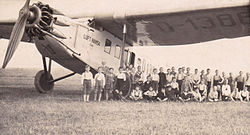Focke-Wulf A 17
| Focke-Wulf A 17 | |
|---|---|

|
|
| Type: | light airliner |
| Design country: | |
| Manufacturer: | |
| First flight: |
1927 |
| Number of pieces: |
approx. 20 |
The Focke-Wulf A 17 " Möwe " was a commercial aircraft from Focke-Wulf Flugzeugbau AG . At the end of the 1920s, it was considered the most economical aircraft ever.
history
Due to the positive experience with the A 16 small airliner, Focke-Wulf also saw good sales opportunities for a larger aircraft. With the A 17, too, the focus was on high economic efficiency and low acquisition costs. First two versions were produced, these were the A 17 (420 hp Gnome-Rhône-Jupiter star engine) in 1927 and the A 17a (480 hp Jupiter engine with gearbox) in 1928.
The first A 17 was used after the type test flights at the German Research Institute for Aviation in Adlershof by the Norddeutsche Luftverkehrs AG in the North Sea bathing service. In 1928, Deutsche Luft Hansa placed an order to build ten A 17a version machines. These were put into service in the same year and named after cities in northwest Germany (Emden, Osnabrück, Münster, etc.). In 1929, Luft Hansa also used this type on the international routes Berlin-Zurich and Berlin-Paris, and by August 1929 had covered over 1 million flight kilometers. In the first 2½ years of use, the A 17 and A 17a handled around 12% of the total scheduled air traffic of Luft Hansa.
In 1932, an A 17a was converted into a so-called Kinder-Möwe and used for sightseeing flights, which were offered for 2.50 Reichsmarks. It was not until 1936 that the last two Lufthansa A 17a (D-UNIK “Münster” and D-UTOS “Hannover”) were cannibalized.
construction
The cantilevered shoulder-wing decker was constructed in a mixed construction of steel and wood. The axleless landing gear was supported on both sides with a vertical strut to the wing and an oblique strut to the fuselage. The outer parts of the wings had the Zanonia shape typical of early Focke-Wulf designs to improve lateral stability. The tanks placed in the wings formed part of the wing nose and ensured a maximum flight time of about four hours.
The closed cabin could accommodate up to eight passengers. The two-person crew also sat in a closed cockpit with dual controls. The two luggage compartments were located under the cockpit and at the end of the fuselage next to the toilet.
Further developments
In the case of four other copies commissioned by Lufthansa in 1929, the installation of BMW VI engines with 650 hp was required. Together with improvements to the cell, this led to a significant increase in weight, whereupon this variant was given the new designation A 29 . The external differences to the A 17 were limited to the engine, the front cooler, the horizontal stabilizer and a modified cockpit glazing. Two copies of the A 29 (D-1757 "Friesland" and D-1867 "Westphalia") were in service with Luft Hansa until 1933.
Another aircraft in this series was used by the German Research Institute for Aviation as a test vehicle for aircraft engines and was designated the A 26 .
The last version of the Möwe was the A 38 , of which Luft Hansa ordered four copies for cargo and passenger flights in 1931. The division of the fuselage was fundamentally changed here, a cargo hold was installed between the cockpit for the three-person crew (pilot, on-board attendant and radio operator) and the passenger cabin for ten passengers. There was also a cargo-only version, with even the wing roots being included as auxiliary cargo spaces. The A 38 flew on the Luft Hansa routes from 1931 to 1933.
Technical specifications
| Parameter | A 17 | A 17a | A 29 | A 38 |
|---|---|---|---|---|
| crew |
|
|
|
|
| Passengers |
|
10 | 8th | 10 |
| length | 13.00 m | 14.63 m | 14.80 m | 15.40 m |
| span |
|
|||
| Wing area |
|
|||
| Take-off mass | 3610 kg | 4000 kg | 4400 kg | |
| Summit height | 4000 m | 5000 m | 4700 m | 3500 m |
| Top speed | 169-180 km / h | 198–201 km / h | 198 km / h | 204 km / h |
| Engine | A Gnome-Rhône Jupiter (420 hp) | A Gnome-Rhône Jupiter (480 hp) | A BMW VI (450/600 hp) | A Siemens Jupiter IV (510 hp) |
literature
- Johannes Müller: The aircraft of the German Lufthansa 1926–1945 - Focke Wulf Möwe . Flight Revue July 1965, p. 54 ff.
Web links
Remarks
- ↑ According to the company tradition of that time, all Focke-Wulf aircraft had internal bird names.

